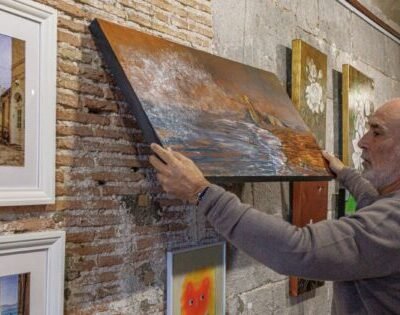
Research: Is Art a Good Investment?
A man photographs the work, “Burger King,” at the Banksy: The Unauthorised Retrospective exhibition at Sotheby’s S2 Gallery in London, 2014 (Reuters photo by Neil Hall)
Art has been emerging as a new asset class for the well-diversified portfolio. The reported returns are enough to catch anyone’s eye: the index of fine art sales, used by art advisors to sell art funds, shows an average annual return of 10% over the past four decades.
Quote
Investors are embracing art-as-an-asset-class as if it were a newly discovered van Gogh. But is it?
Attribution
Arthur Korteweg
Investors are eager to buy: Many so-called passion investments have been gaining in popularity, and a handful of funds, such as The Fine Art Fund Group, led by CEO Philip Hoffman, are making it easier for investors of all income levels to put their money into fine art.
In short, investors are embracing art-as-an-asset-class as if it were a newly discovered van Gogh. But is it?
Research we completed recently and presented in August 2013 at the European Finance Association conference shows investors would be wise to be wary. The returns of fine art have been significantly overestimated, and the risk, underestimated. Our research, based on the most complete auction database, BASI (Blouin Art Sales Index) shows the true annual return of art as an asset class over 1972 to 2010 was closer to 6.5%, instead of the 10% that the index shows. Moreover, holding an art fund in your portfolio does not increase the chances that the portfolio will outperform.
The underlying cause of the overestimation of returns (and an accompanying underestimation of risk) is what is known as selection bias. People have suspected this bias in the indices used to report returns of some alternative asset classes for years, but our analysis is the first, we believe, to find a way to account for it.
The selection bias arises when returns are based on indices built on repeat sales of fairly illiquid assets that are not sold at random. Many of the returns based on those kinds of indices — including the S&P/Case-Shiller Home Price Indices — may be biased upwards.
Not only are the returns of art lower than investors think, but also the risk is higher. Our analysis, of 20,538 paintings repeatedly sold between 1972 and 2010, found the Sharpe Ratio for art is 0.04, rather than the 0.24 that has been previously found. The Sharpe Ratio on U.S. equities over the same time period is 0.30. (The Sharpe Ratio is the risk-free rate of return — such as that of the 10-year U.S. Treasury bond — subtracted from the average rate of return for a portfolio or asset class, divided by the standard deviation of the return on the portfolio or class. It is the best tool for comparing asset classes on a risk-adjusted basis, and is often used by researchers to develop ideas for the best portfolios.)
The selection bias in art occurs for several reasons. Among them: Paintings that happen to be in high demand tend to go to auction more frequently and sell at higher prices. People also tend to sell the paintings that have increased in value the most since the time of purchase. A similar selection bias is probably at work in real estate, when, for instance, people sell houses after they have appreciated a lot in value.
Here’s an illustration of the way this works in the art market:
Imagine two paintings were purchased at an art dealer in 1972, each for $10,000. The career of one of the artists, Roy, took off, and the painting by him is sold in 2010 for $20,000. The other artist, Tony, turned out to be a flash in the pan. That painting was never sold; but say, for the sake of argument, that it retained its $10,000 value. As the artist faded from public view, it remained on the living room wall.
The art index — one of those repeat sales indices we mentioned before — uses the price appreciation for Roy’s painting to assign a value to Tony’s painting. According to that calculation, each painting is worth $20,000. The index therefore would report the return on the investor’s original $20,000 at 100% — $40,000, although in reality she realized only a 50% return, as she owns paintings worth $30,000, not $40,000.
If Roy’s painting were an average painting, using it to assign a value to paintings like Tony’s wouldn’t be a bad way to estimate returns. Our research shows, however, that the paintings that sell are far from average: They are those that appreciate the most in value. To impute a more accurate value to the paintings that never sell or sell less frequently, our methodology uses what we know about how rapidly the paintings that sell have appreciated, and how often they are sold.
Our model allows us to look at five different styles of painting, including Post-War and Contemporary, Impressionist and Modern, Old Masters, American, and 19th-Century European. In addition, we considered the returns of paintings by top-selling artists.
As an aside, we turned up some interesting facts about the art market. More than 2% of sales occur within two years after the artist died, confirming a generally held view in the art world that death sells. The average hammer price in the full sample was $61,939, with a long right tail of extremely expensive paintings. About 22% of sales took place at Christie’s, and 25% at Sotheby’s. Among the styles, the Impressionist and Modern style accounted for one third of sales, followed by European 19th-century paintings with about one-quarter. About 16% of sales were of Post-War and Contemporary paintings, 12% were American paintings, and 5% were Old Masters.
The conclusion about art as an investment is clear: When we compared the investment returns and risk of all the styles of art to a portfolio of pure stocks, we found that art investments would not substantially improve the risk/return profile of a portfolio diversified among traditional asset classes, such as stocks and bonds.
Our analysis applies to art purchased via a fund. What about art that you buy on a one-off basis? In other words, what if you are a smart and tasteful collector of art who enjoys art but also buys with an eye to reselling it to make a good return? This is the equivalent of investing in a single stock or a tiny handful of them: You might be one of the few people with the skill or luck to pick winners, but chances are you are not. And if you own a painting, you bear the physical risks and costs, including insurance, damage, and theft or forgery, among others.
In short, buy paintings if you like looking at them. You can hope that your children will sell one or more of them later for a gain — but paintings are primarily aesthetic investments, not financial ones.
Arthur Korteweg is a former associate professor of finance at Stanford Graduate School of Business; Roman Kräussl is an associate professor at Luxembourg School of Finance; Patrick Verwijmeren is a professor of corporate finance at Erasmus School of Economics.






No Comment! Be the first one.